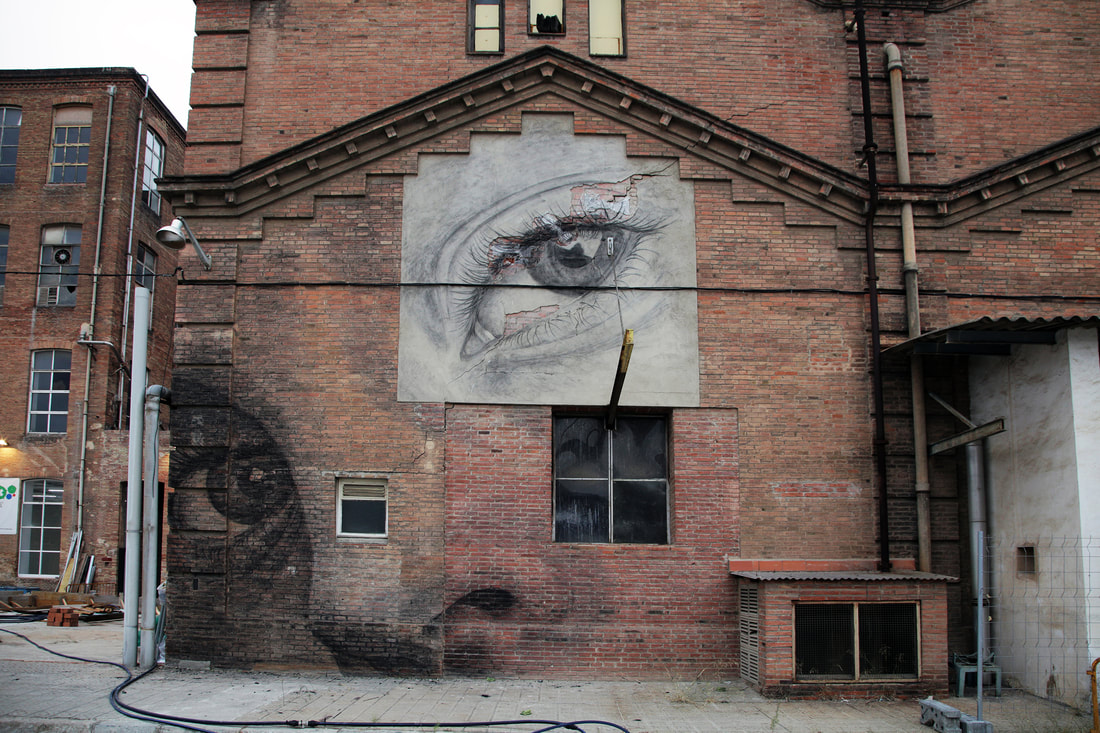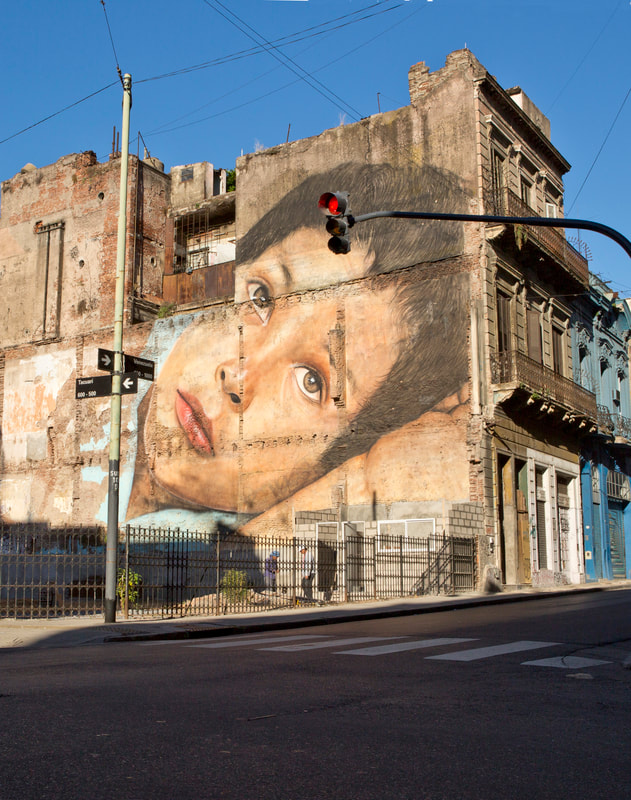|
THE WORK OF ARTIST JORGE RODRIGUEZ GERADA HIGHLIGHTS THE SMALL AND TAKEN-FOR-GRANTED ON A MONUMENTAL SCALE.
MILIA WALLENIUS | ARTICULATE #21 | OCT 2019 Cuban-American artist Jorge Rodriguez Gerada (b. 1966) is a contemporary artist and street artist known for his large-scale urban artworks, found in cities across the globe.
Gerada’s impressive artistic career started in New York in the 1990s where he, as a founding member of the anti-consumerist Culture Jamming movement, hijacked and altered billboards and other public advertising in order to change their message. This has gained him world-wide recognition as both a social artist and activist.
Although Gerada has moved on from altering billboards and corporate advertisements, his work still centers around contemporary social themes, local communities and progressive change. Such themes are present in his 2019 mural PROMISE, painted on the outer wall of an apartment building in Turin, Italy. The mural is part of the ongoing project Toward 2030: What are you doing? – an urban art and awareness initiative and collaboration between Italian coffee company Lavazza and the city of Turin. The project centers around the Global Goals of the United Nations and consists of 17 murals by different artists, each mural representing one of the 17 goals. Gerada’s painting is about affordable clean energy, which is goal number seven. The mural depicts a girl touching the logo of Toward 2030 goal number seven, letting loose a flow of clean energy. The mural was created to bring awareness to the importance of accessible and affordable, clean energy and the environmental, social and economic challenges related to it. A large amount of the energy produced today is for example still obtained from polluting fuels, while another large number of people still do not have access to electricity.
As the name of Gerada’s mural suggest, the piece holds a sense of hope and a promise of a better future. At the same time, it also encourages us to make a promise and to act now in order to assure that future. The deadline established by the United Nations to transform the planet into a more sustainable place is 2030. Gerada started working with murals in the public urban sphere in the early 2000s, when he moved to Barcelona, Spain. Although his present-day work still echoes the defiant and political aspects of his early art, a closer look shows a more relaxed and calm approach to art in the urban sphere. It lacks the narcissism and the loud, aggressive aesthetic of street art.
Pushing what street art is and what it can be, Gerada’s work mixes an urban aesthetic with a more traditional artistic practice rooted in craftmanship and technical skill. |

Gerada’s compositions are calm yet powerful, sensual and present. They are thought through, like his subject matters.
“I like to have a set idea of what I am about to create. But I enjoy and listen to what the process has to say. Sometimes unexpected twists, turns or mistakes in the process can be golden”, he explains. Gerada’s projects are carried out with remarkable precision, resulting in a detailed, strong and solid product. His work pay homage to street art and the classical arguments of urban art practice, but also history and tradition. Gerada is interested in narratives and people, and he does indeed work with portraits. Based on photographs of real people, sometimes of several, they all represent a story.
Painted on walls and other surfaces in the urban environment, Gerada’s murals are part of the city and its ever-changing landscape. For people passing by they offer an unexpected encounter, an untold story. For local comminutes they become part of the everyday living environment. Painting on walls and other natural surfaces is in no way new and goes beyond street art. Looking at history, paintings have been found in caves, at ancient burial sites and buildings. Used for decoration or communication, often bearing religious meanings or signifying power or wealth, these monumental pieces were created to last.
Gerada’s people are however not kings, queens, gods or goddesses, but ordinary inhabitants of a city. People that often pass unnoticed into history and yet they are the ones that give a city life and shape its culture. Gerada highlights the importance of these everyday individuals. Making us want to know more about them. Making us wonder what the stories of these people are. His pieces document the souls of a city, giving the city a face. The core of Gerada’s creativity is found in the stories, the cities and the diversity of their habitants. This is also what is celebrated in CÔR / CORE – a monumental painting of a heart with veins, located at the Parc dels Pins in Santa Coloma de Gramenet, Spain. The colorful painting, which was completed in 2018, was inspired by the multiculturalism of the city and the unity of the 114 or so different nationalities residing there. |
The symbolism of the piece is that of a collective heart, an essence and a soul, where the different stories of people come together creating the core of the contemporary city itself.
Celebrating difference and multiculturalism, Gerada shows true interest in the city, its people, the richness of communities and the collective spirit, their importance and prosperity. Although monumental works often are created to last, Gerada’s pieces hold an ephemeral quality. In 2002 he started his IDENTITY SERIES, a series of large-scale charcoal drawings of anonymous people drawn on various walls in the urban sphere. Due to the materials used the drawings fade and will eventually disappear with time.
Here Gerada’s work shows a sense of time and temporality. His pieces reflect a certain vulnerability and awareness of transience, but also the ever-changing urban landscape and the millions of souls, coming and going, that inhabit it. Another direction that fades away is his land-art. Built in a certain environment with the materials the environment has to offer, Gerada works in a tradition that started in the 60’s and 70’s by artists such as Robert Smithson. Interested in ecological movements and rejecting the commercialism of the art world these artists started creating pieces out in the wild. Once again working with portraits Gerada’s TERRESTIAL SERIES is a series of earthworks created on the ground and so impressive in size that they can be seen from space. This means that the works of this series cannot be fully experienced on the ground but require tools such as Google Maps in order to be fully seen. Like the landscape itself, these pieces will change and fade over time. Although Gerada is mostly known for his murals and land-art, his artistic production is not limited to these alone. Lately Gerada has been interested in experiments with and the combination of art and technology. Also, here he remains interested in people and urban environments. His production also includes smaller pieces, paintings drawings and sculpture. Among these is his series FRAGMENTS. Like the name suggest this is a series of fragmental portraits painted on fragments of old, multilayered interior wall paint, removed from abandoned buildings. This unique material is at least 150 years old. By using it as a canvas, Gerada assigns importance to weathered and worn urban surfaces and commonplace textures, very much present in a contemporary urban setting, but often bypassed. The paintings, showing only parts of the faces they portray, resemble archeological findings, incomplete objects and remnants of another time. They present themselves as pieces of a story yet to be discovered. Once again, Gerada’s works reflect the passage of time and show a sense of history. At the same time, these pieces recognize the unique beauty of old wall surfaces, left behind by previous generations. Multitalented, Gerada chooses his medium based on what he wishes to say with a piece. The size and medium are an important part of the overall message. In the end the story is what allows him to choose the material, aesthetic direction and subject. Despite the often enormous proportions of his pieces they focus on the small and the common. They portray everyday people – the human at the street level – that constitutes the living essence of a city, providing it with life and color. Something indeed worth celebrating. This article about JORGE RODRIGUEZ GERADA takes part of 5th anniversary magazine, ARTICULATE #21. Read, download or order your print version of the full publication below
|
SUPPORTARTICULATE
www.articulate.nu SUPPORT Monday - Friday 8:00 - 16:00 [email protected] +45 30 48 19 81 Head Quarters VAT DK40953191 |
|










